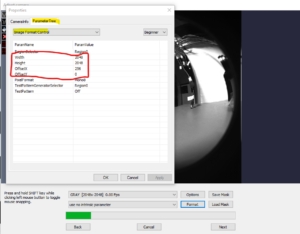Using HIK Vision Cameras within VIOSO 6
Once the camera is configured, MVS software must be closed.
The camera will show up as “DirectShow” device with a device name like “HIKRobot MV…”. All parameters are available in a large parameter tree, that can be filtered by categories and complexity (“Guru”, “Beginner”…). Though all parameters seem accessible, it is not recommended to do much changes here, because of a bad user experience:
It is hard to browse through the vast parameter tree
After each parameter change, the dialog closes and must be re-opened and browsed through again
For “last minute” changes, though, we recommend to concentrate on these parameters:
Acquisition Control: Manipulate here the “Exposure time” to adjust the camera sensitivity to the test pattern displayed by the projectors
Image Format Control: Use the values “Width/Height” as well as “OffsetX/Y” to enter a (well known) region of interest:


Example: To crop the image of a fulldome calibration kit to fit the lens…
set Width = 2048
set OffsetX = 256

Since the usability of these dialogs is challenging, we recommend to make these settings in the MVS application.
Notes about Multi-Camera usage:
In MVS, when switching between cameras views, stop acquisition on the previous first or you will have bandwidth error warnings.
In VIOSO MRD window (Model View Control) you might not see the camera full name in the dropdown menu. To check if it’s the right camera assigned, open the MRD file you created in a text editor. It is in XML format where
defCamNameparameter refers to the camera that calibrated the selected compound.Optional tip: It can be helpful to fix camera custom names in MVS (Right Click the camera > Rename User ID ). They will appear in VIOSO under “adjust camera > Options > Camera info”
Last updated